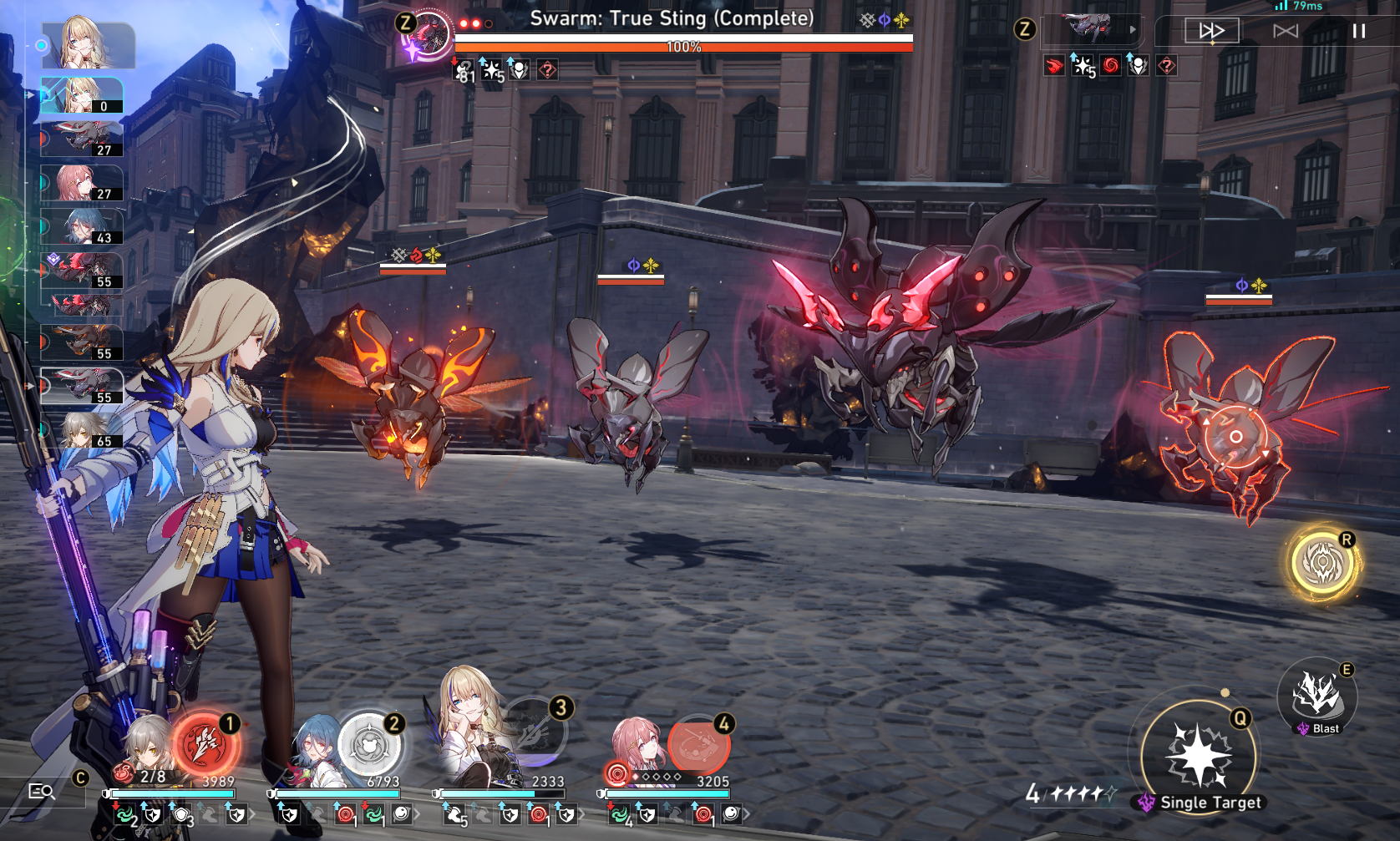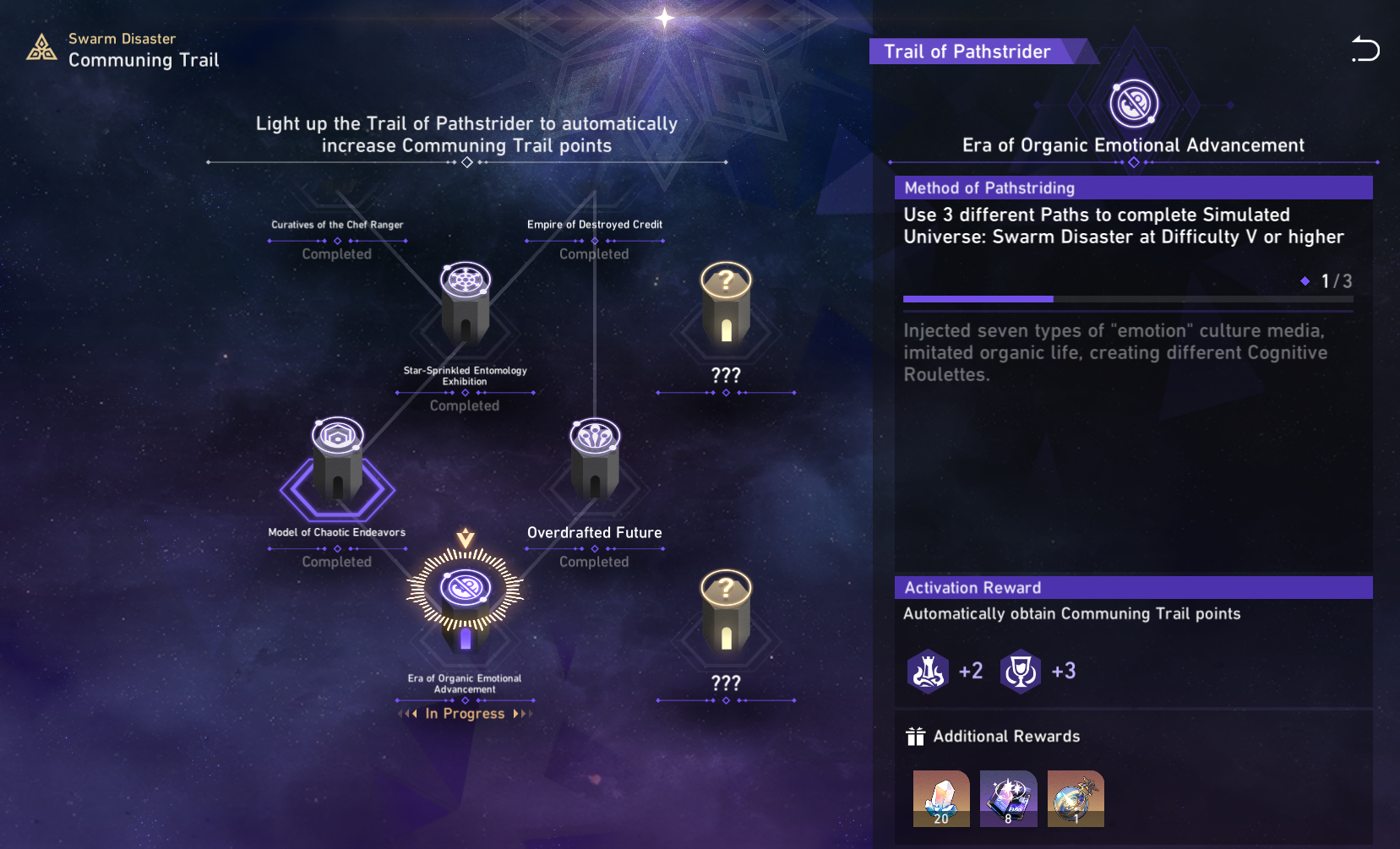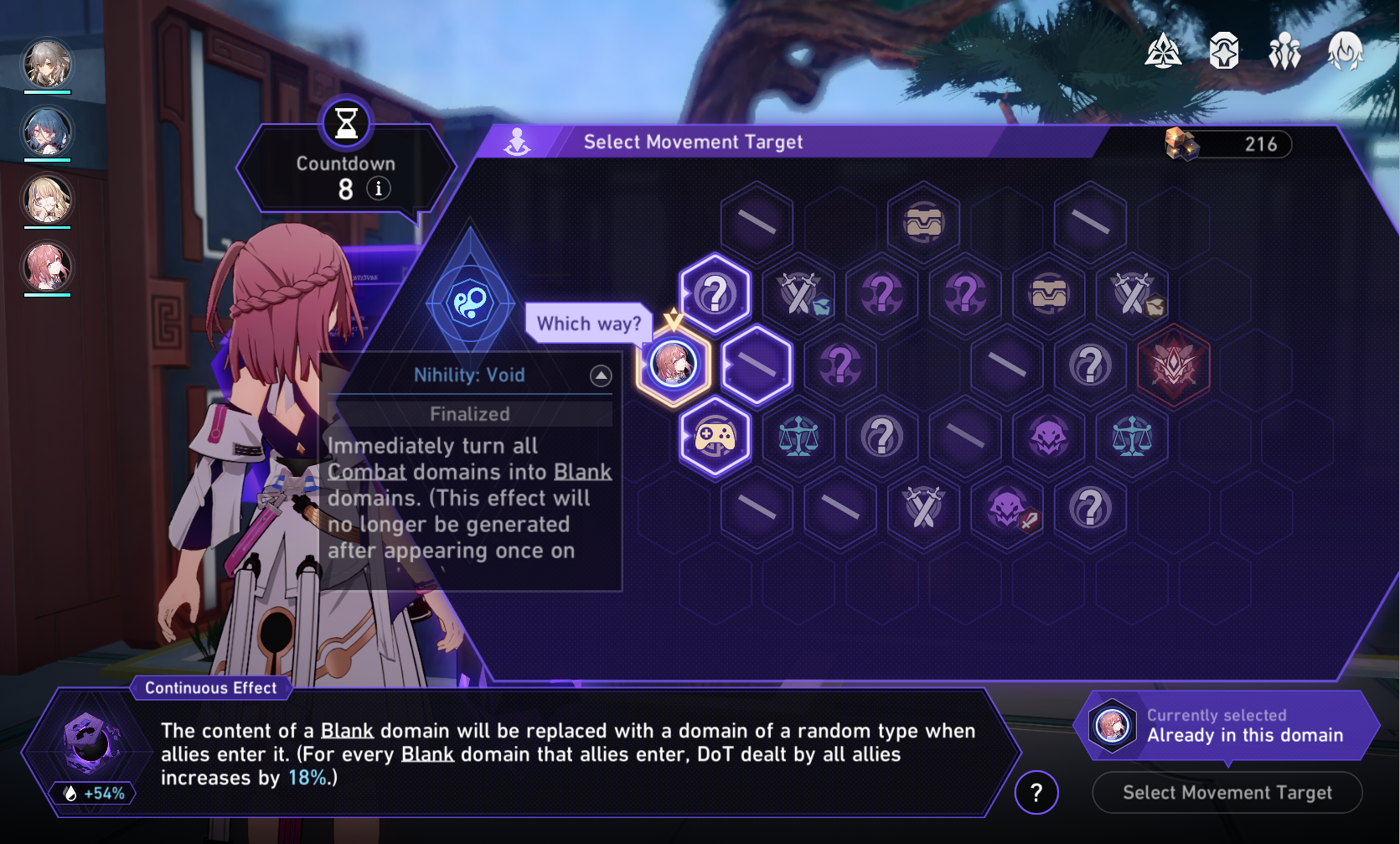Swarm Disaster is a feature expansion for the Simulated Universe (SU) and introduces a separate game mode with plenty of new Blessings, Curios, Events, and Path Resonances. The new game mode has a fair bit of complexity and is definitely a huge step up in difficulty compared to the regular SU. In addition to a new progression system, Swarm Disaster also adds Propagation as a playable Path, which can be unlocked for regular SU as well. Let’s go over how Swarm Disaster works and how to unlock Path of Propagation.
Swarm Disaster
To access Swarm Disaster, you need to have Simulated Universe World 5 cleared and complete a series of tutorial quests with Herta. Just like a regular SU run, you will select one of the Paths available. Initially, most of the paths will be locked behind the tutorial quests and various objectives in Swarm Disaster. You can click on the locked Paths to see the unlock requirements.
While Swarm Disaster retains many familiar elements from SU, its core gameplay revolves around the ‘Audience Journey’, which requires you to traverse board game style maps called ‘Planes’. Each tile on the map represents Domains that can be completed for Blessings, Curios, and Cosmic Fragments. Every run of Swarm Disaster consists of three Planes, with a Boss Domain at the end of each.
Domains
Many of the Domains should look familiar, such as Combat, Elite, Occurrence, Respite, and Boss. Transaction Domains are slightly different in Swarm Disaster, as you can spend Cosmic Fragments to purchase a random selection of Blessings and Curios from Screwllum and Herta, as well as revive any dead characters.
Two of the new Domains are Reward and Adventure. Reward Domains grant you an Occurrence event to gain rewards, while Adventure Domains are timed challenges that require you to break destructible objects or catch Trotters. Getting a high enough score will earn you Cosmic Fragments, a Blessing choice, and a Curio choice.
Swarm Disaster also brings ‘Swarm’ variants to Combat, Occurrence, and Boss Domains. These Domains are focused on a new type of enemy called True Stings and will be your main way of obtaining Blessings from the Propagation Path. In Combat and Occurence Domains, you will be fighting young variations of True Stings, called Lesser and Juvenile Stings.
Lesser Stings can spawn periodically throughout the fight and initiate a self-destruct ability that detonates on two characters, inflicting them with a dispellable debuff called Outrage. Characters with Outrage cannot be controlled and will automatically attack on their own. Meanwhile, Juvenile Stings have an ability called Meiotic Division, allowing them to spawn another Juvenile Sting every two turns. In combination with Lesser Sting spawns, this can prove troublesome for teams that struggle to kill them faster than they can multiply. Fortunately, when True Stings die, they explode and inflict damage to all friendly units, similar to Illumination Dragonfish on Xianzhou Luofu. You can capitalize on this by strategically lowering their health before killing one to cause chain explosions.

Lastly, there are three Boss Domains, one at the end of each Plane. Unlike normal SU, the first two Planes will allow you to select one of two random Bosses to fight. Each Boss will provide a beneficial effect for the final Boss Domain. The first Plane will always be a random selection of Elite type enemies, while the second Plane contains story Bosses like Cocolia and Kafka. The final Boss Domain on the third Plane will always be the Boss version of a True Sting.
Beacons
Beacons are additional effects that can randomly spawn on top of Domains, which provide extra rewards upon completion. There are four types of Beacons: Enhance, Mutation, Blessing Trotter, and Curio Trotter. Beacons can be identified by an icon on the lower right-hand corner of a Domain. Certain Paths, such as the Hunt, can also generate Beacons on top of existing Domains.
Countdown & Planar Disarray
Planning your movement across the Plane is very important when it comes to getting stronger in Swarm Disaster. While you move towards the Domain Boss, tiles behind the Domain you choose will deactivate, preventing any backtracking. In addition, there is a Countdown mechanic that ticks down each time you move to a new Domain. You can see the Countdown right next to the Plane map.
If the Countdown goes past zero, it will activate Planar Disarray. During Planar Disarray, the Countdown is replaced by a Disruption Level that increases with each move. The higher the Disruption Level, the stronger enemies become. While exploring additional Domains can potentially make you stronger, it also poses the risk of empowering enemies beyond your capabilities. This adds a fun element of balance for you to think about while navigating with various Paths and teams.
Audience Dice
Audience Dice is another important feature when it comes to choosing your route through the Planes. Each Path has a unique set of Dice Effects that can be used to manipulate Domains or gain special buffs. They are also vital in helping strengthen a Path’s Continuous Effect.
After leaving a completed Domain, an Audience Die is rolled to randomly determine a Dice Effect from your Path before choosing the next Domain. You have the ability to reroll the effects or use the ‘Cheat’ function to manually select one. While Reroll and Cheat counts are limited, you can actually obtain more charges from specific Curios.
New Path Effects & Interplay
Each Path has a Dimension and Continuous Effect, which provide unique ways to enhance their strength. Dimension Effects occur right when you enter the first and second Planes. Continuous Effect is a permanent passive buff that you can strengthen based on each Path’s specific requirements. For example, Nihility’s Dimension Effect transforms two random Domains into Blank Domains, while its Continuous Effect strengthens DoTs for each Blank Domain you enter. In combination with Audience Dice, Continuous Effects are one of the best ways to strengthen your team.
Nihility’s ‘Initial/Passive Effect’ is most likely an inconsistent translation, as the rest of the game refers to them as ‘Dimension/Continuous Effect’
Another Path feature introduced in Swarm Disaster is Resonance Interplay. Resonance Interplay is an extra effect that a Path Resonance can acquire by collecting Blessings from different Paths. Each Path has two Resonance Interplay effects that require Blessings from specific Paths to activate. For instance, Elation can receive Resonance Interplay through Blessings from Remembrance and Abundance. To activate them, you first need your chosen Path’s Resonance (three Blessings), followed by three Blessings from each of the Paths associated with the Interplay Effects.
Emergency
Emergencies are random events that can potentially trigger after each Domain. These effects usually transform existing Domains to Swarm variants. You can also obtain a Sealing Wax of Propagation from Emergencies, which grants you a Propagation Blessing.
Communing Trail
The Communing Trail in Swarm Disaster is essentially a more powerful version of the Ability Tree seen in regular SU. Points in each Path provide incredibly strong buffs and can make it easier to tackle higher difficulties of Swarm Disaster. Buffs gained from each Path are also applicable to all the other Paths. Unlike the Ability Tree where you can simply run SU for points, leveling up the Communing Trail depends solely on completing various objectives from the Trail of Pathstrider.
Trail of Pathstrider
Trail of Pathstrider, as mentioned before, consists of a series of objectives that you must complete to level up your Communing Trail. Each Pathstrider objective grants a predetermined number of points to specific Paths on the Communing Trail. Unfortunately, some of these objectives can be quite frustrating to complete and may require you to compromise your run to accomplish them. This can make progression feel like a grind, especially when the objectives are not retroactive. It’s important to note that you must unlock each Pathstrider node by completing earlier nodes before your progress towards it can be counted.

Besides the regular objectives, there are also hidden objectives located on the right side of the Trail. These objectives require you to make a total of 20 Path-specific choices during Swarm Disaster. There are seven hidden objectives corresponding to each of the Paths, except for Propagation. You can expect a Path choice to appear after defeating a Boss Domain, and there’s also a chance they may appear during Occurrence event choices.
Path of Propagation
To unlock Propagation as a selectable path in both Swarm Disaster and regular SU, you must collect all 13 Aeon chapters. Each chapter requires a specific level in the Communing Trail for the corresponding Path and completion of various stages in Swarm Disaster. For instance, to collect Preservation Chapter I, you need at least 8 Communing Trail points in Preservation before you successfully complete a second Plane run. You can click on each chapter to check their individual unlock requirements. It’s important to note that you can only unlock one chapter per Plane completion, even if you meet the Communing Trail level requirements for multiple Paths.
Conclusion
Swarm Disaster is a refreshing addition to SU, with many interesting new features to explore. The game mode is permanent, so you can take your time progressing through the multiple difficulties. While Swarm Disaster doesn’t contribute to your weekly SU Points, it does have plenty of one-time rewards, including Stellar Jades, Credits, and Tracks of Destiny. Hopefully they continue to expand on the Simulated Universe with more innovative game modes like this.

















